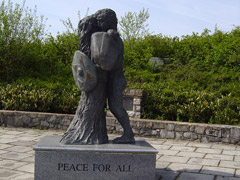Memorials and commemoration

'Peace For All' sculpture by Derek A. Fitz Simons, Aghalane, Co. Fermanagh, erected 1999
For some the border is not just a feature of the disputed political division of the island but also the site of commemorations to those who have died in the conflict over its existence. Memorials to Republicans who died in ‘active service’ during the Troubles can be found near the sites of their deaths, sometimes taking the form of plaques on roads or bridges or small memorial gardens. But the borderlands are also marked by the sites where ordinary people died in paramilitary shootings and bombs or were killed by the British army. In some cases these deaths are memorialised on the ground, in other cases, as with British soldiers, RUC or UDR officers who were killed along the border, they are remembered in private.
The landscapes of the borderlands are also characterised by buildings that serve as reminders of the impacts of the Troubles on borderland lives; abandoned farmhouses near the border suggest stories of fear, threat and intimidation that are remembered locally and by those who have moved away. It is sometimes suggested that these farmhouses remain unoccupied because the Protestant former residents are unwilling to sell them to potential Catholic buyers whereas selling to Protestants would help maintain a Protestant foothold in the countryside. Yet these accounts are deeply emotive and subject to dispute.
The history of the Troubles in the border counties, as in the rest of Northern Ireland, remains a bitter and contested subject whose commemoration is deeply politicized. Accounts of the ‘ethnic cleansing’ of Protestants from the borderlands by republican paramilitaries, for example, are both asserted by some and dismissed by others.
Recent efforts to record the experience of borderland life contain many stories of good relations between Catholics and Protestants but also of families being burnt or intimidated out of farms. The diverse and contrasting narratives being collected about the borderlands suggest the complexity of the issue; memorials on the ground are usually more partisan but also commemorate personal bereavement.
However, the reopening of one cross-border road has also been used as an occasion for erecting a symbol of reconciliation. In 1972 the bridge over Woodford River which forms the border between Cavan and Fermanagh near Aghalane in Co. Fermanagh and about 3km from the town of Belturbet in Co. Cavan was blown up by Loyalist paramilitaries and was not replaced. The destruction of the bridge closed the main route between Dublin, Fermanagh and Donegal and severed the close social, farming and commercial connections between Belturbet and the surrounding countryside in Fermanagh. As with other border towns cut off from their hinterland, the town declined as a result. In 1999 a new bridge was opened named the Senator George Mitchell Peace Bridge in honour the Senator’s contribution to the Peace Process and is accompanied by a new statue symbolising the rebuilding of relationships and reconciliation, inscribed with the words ‘Peace for All’.
The new bridge and road scheme, mostly funded by the EU Special Support Programme for Peace and Reconciliation, is a practical effort to regenerate this border area and stands for new hope for restored connections between people divided by the border and by the Troubles.





